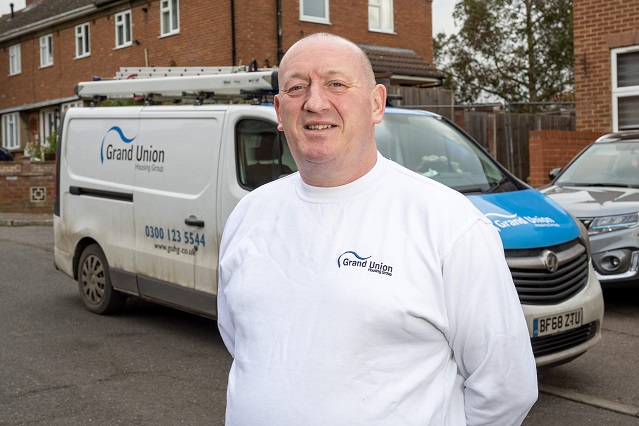Ensuring our customers are safe in their home is our key priority and we’ve been looking at how we can better deal with damp, mould and condensation for the last 18 months.
To show our commitment to this, we have set up a dedicated team to focus on dealing with damp, mould and condensation issues.
Jason Stretton and Stuart McNeal joined Grand Union last year. They’ve gone straight into these specialist roles, and Jason explained the kind of work they’ve been doing.
“I started at the beginning of September; Stuart started a month later. We were both fully qualified, college trained decorators by trade. I was self-employed before joining Grand Union, while Stuart did a bit of maintenance before too.
In our role we tend to be the first visit for damp and mould treatment. When I arrive at a customer’s home, I always try to go around all the rooms to check for any other signs of damp or mould. This can be black marks or smaller spots.
If we find anything, we always try to take pictures first.
After that, we get sheets down and use a specialist product called fungi blitz which is specifically designed to eliminate deep lying mould spores.
We wash the areas down with this and then talk the customer through how long it takes to dry and what the next stages are.”
Part of Grand Union’s approach has been to use technology to help solve damp, mould and condensation issues. Environmental sensors are being installed in homes which track the temperature and humidity in the property. Stuart explained that they also have specialist technology they use on their visits.
“We also use damp meters which help us flag up if there’s a greater issue to look into rather than customers not properly ventilating.
These measure the levels of moisture in walls which allow us to where an issue could be coming from.
There are certain signs we can recognise too by eye. Sometimes you can see signs of damp in a corner of a room, so I’d have a look outside to see if there’s anything that could be causing it, such as a blocked gutter. We’re always looking for reasons.
We check that they have things like trickle vents on their windows open. We check to make sure they aren’t clogged up and open properly.
Bathrooms and kitchens tend to be the main areas we treat, so we always check to see if the extractor fans are working too and give them a clean if needed.”
While Grand Union never treat damp, mould and condensation as a lifestyle issue, the team know that it can often be really useful for them to pass on useful advice and guidance that will help reduce or even remove the issues.

Stuart explained: “I visited a customer recently who was drying her washing inside, which we all do during the winter. If you put your washing outside in November, you’ll be bringing it in in March! However, she said she didn’t open the trickle vents because it’s too cold.
So that’s where I explained that the moisture needs to go somewhere, so you should open the trickle vents or ideally open the window in the room for a bit.
I tell customers about a chap I used to know who would go around every morning or evening and open each window, then go back straight back and close them all.
You might feel the cold for two to three minutes, but the important thing is that you’ve changed the air in that room.
We suggest lots of little things and even if customers don’t do everything, doing one or two can really make a difference.”
Jason added: “We understand it’s tricky though with the cost-of-living crisis at the moment. People are dubious about having the windows open and letting heat out if it’s cold outside. That’s fine, but we often find people with radiators crammed with things drying and sofas push in front of it. Houses are like us; they need to breathe.
I’ve also visited a few homes where people don’t open the curtains to try to keep the heat in. All that does though is contain moisture in the home – from cooking, showering and even breathing.
We obviously aren’t trying to tell people how to live, but we can advise them on how to make a difference.”
Advice and guidance are really useful, but often, if mould and damp have taken hold, it needs expert treatment, as Stuart explains.
“When you see small dots of mould on a ceiling or wall, you know that it will spread if left untreated.
That’s why you need professionals like us to come and treat it properly. A bit of bleach on it is only masking the issue.
We’ve had one or two customers who didn’t want to wait for the second and third stages and have painted over it themselves. That can be frustrating because chances are the mould could come back.
We need to kill the mould, seal the wall, and then paint it – that’s why we do multiple stages.
Both Jason and Stuart know that they’re playing their part in making a difference to customers, helping to ensure they are safe in their homes. And it’s knowing this that make the job so rewarding, as Stuart says.
“It’s not the most glamourous of jobs, but if we can make customers’ lives better by giving them a safe environment to live in, then that’s the whole aim of the game. The nature of the job is to give people a safe environment to live in and that’s all that matters.”



